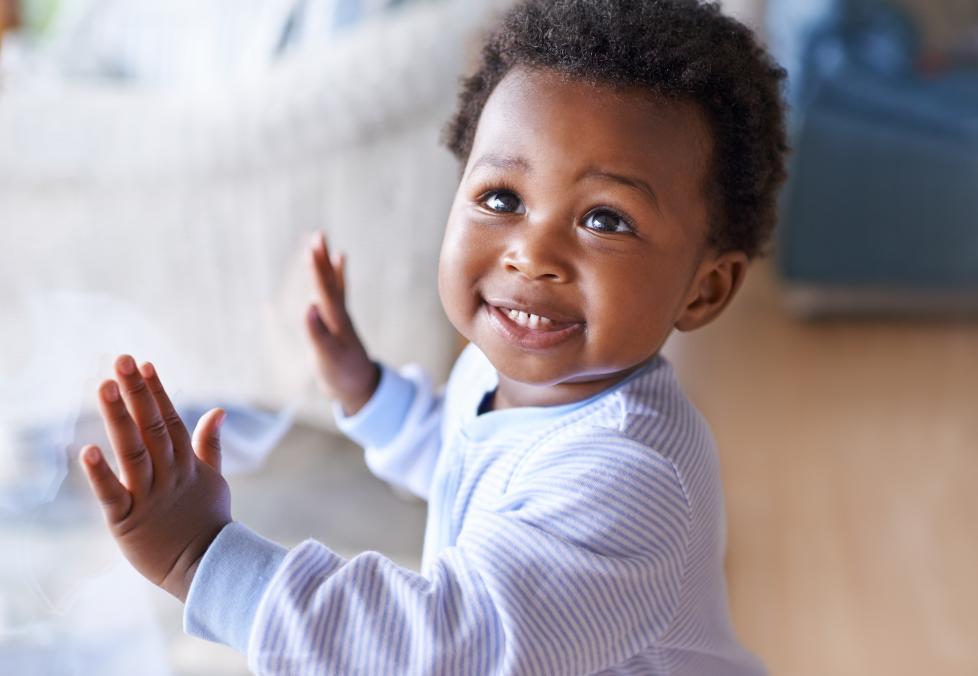
Treat your eyes to a free quality eye exam with our popular two-pair offer.
Everything you need to know to take care of your eyes — for life.
When you’re playing with your infant, look for these signs of eyesight development.

You track everything about your newborn: naps, meals, diaper contents. But there’s one more thing to keep an eye on, and that’s your child’s vision.
After all, noting her visual progress helps you catch problems and seek treatment early—crucial for the future of your child’s vision and eye health.
Optometrist and new mom Elizabeth Walsh Czirr, O.D., F.A.A.O., knows that as well as anyone.
“The eyes are how babies communicate with the world,” says Dr. Czirr, of Nashville Regional Eyecare, located inside an America’s Best Contacts & Eyeglasses. “They can’t talk. They don’t do a lot of moving around in the early stages. They’re taking it all in through the eyes. And as the eyes and brain are developing, you want to make sure they hit certain milestones.”
Most of these indicators are easy to spot if you know what to look for. No need for fancy equipment or elaborate charts. Just play with your little one and observe what she does, says Dr. Czirr.
“I’ll try to stimulate my daughter in lots of different ways,” says Dr. Czirr. “We’ll go to the window and look outside, and I’ll talk about the birds and the colors we’re seeing. Or I’ll put a block in a cup, then cover it up and say, ‘Where did it go?’ Just being with your baby and playing with them is good for their visual development.”
Notice anything unusual? Book an appointment with your eye doctor.
And even if everything appears healthy, be sure to schedule your child’s first eye exam at about six months old (or before they turn one), Dr. Czirr says.
Meantime, here are seven quick assessments you can administer yourself.
Did you know that kids with vision problems should get their eyes checked every year? Now’s the time to book an appointment! Click here to find an appointment time that fits your schedule.
One of the first things Dr. Czirr checked her daughter for was strabismus, when one eye wanders in, out, up, or down.
“There are types of strabismus that happen right at birth,” Dr. Czirr says. “So I looked for that first.”
Many newborns have uncoordinated eyes, which may appear to wander or cross, according to the American Optometric Association (AOA). And some babies, particularly those of Asian descent, can have false strabismus—when the shape of the eyelid causes the illusion of an eye turn, Dr. Czirr says. The effect should go away as the baby’s face begins to grow.
Still, if the eye turn is constant or if your child’s eyes do not straighten out by four months, call your eye doctor, the AOA recommends. The condition may signal a problem with eye muscle control and can lead to lazy eye or crossed eyes.
“If one eye is looking in or out, it’s not going to develop and learn how to see,” she says. Glasses may help, and surgery could be an option, too.

Treat your eyes to a free quality eye exam with our popular two-pair offer.
Early on, infants are mostly interested in objects very close to them. “Their world at first is the 8 to 10 inches right in front of their face,” says Dr. Czirr.
Keep reach-and-touch toys within that range to encourage visual development. By about two to three months, babies will usually start reaching for things and batting at nearby moving objects.
“It’s important to show them objects and have them look around,” she says.
By two months, most babies develop stable eye contact with their parents. If that eye contact declines, it may be an early indicator of autism, suggests research from Emory University School of Medicine.
In the study, infants later diagnosed with autism showed a steady decline in eye contact between the ages of two and six months. The finding may pave the way for earlier diagnosis and treatment, the National Institutes of Health reports.
Concerned? Check in with your eye doctor to rule out ocular issues. Then, depending on the results, follow up with your child’s pediatrician to talk about early intervention services.
Check your little one for smooth “pursuits,” the kind of eye movement that allows you to follow or track a moving target, says Dr. Czirr. At two to three months, she should be able to follow a toy or other moving object that’s close to her face.
And around five months, she can track objects at a distance, too. To make sure her tracking is on point, walk around the room both while talking and in silence. “With babies, it may be the sound that causes them to look,” she notes.
Poor tracking ability may be a sign of blurry vision due to a refractive error. Or a miscommunication might be happening between the eyes and the brain, she explains. Your eye doctor will be able to make that call. And be sure to keep your pediatrician in the loop.
Depth perception is not present at birth and won’t develop fully until about five months old. At that point, your baby should be able to reach for and grab objects.
“Do they grab it right on, or are they over- or undershooting it?” Dr. Czirr asks. If so, it could indicate a refractory error. Or it could be a strabismus that’s too subtle for you to notice.
Check by covering one of your baby’s eyes and then the other—incorporate it into a game of peekaboo, Dr. Czirr suggests.
“If they get very upset if you cover one eye versus the other, that could mean the one eye has something going on.”
Notice any redness, crustiness, or excessive tearing? All can hint at an eye problem.
Redness or encrusted eyelids could be signs of an eye infection, while excessive tearing (even when she’s not crying) may suggest blocked tear ducts.
And check your baby’s pupils, too. Cloudy white pupils, which may appear silvery or yellow in bright light, can be a sign of a congenital cataract or of retinoblastoma, cancer of the retina. Both are rare, but serious.
“Often parents will take a picture of their kid, and the flashback of the camera produces a white reflex instead of a red one,” Dr. Czirr says. See white? Visit your eye doctor right away.
Sure, you’re excited to see those first steps. But staying on all fours for longer is better for visual development, according to the AOA.
By engaging the hands and the eyes, crawling helps develop hand-eye coordination better than walking does. Most babies start crawling around eight months and try to walk at about a year old.
If your child is slow to crawl, it may be a sign of a vision problem. But there are many possible reasons, so it’s best to ask your doctor.